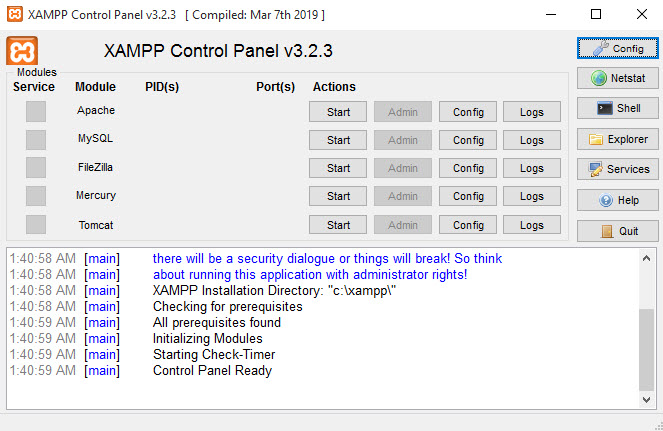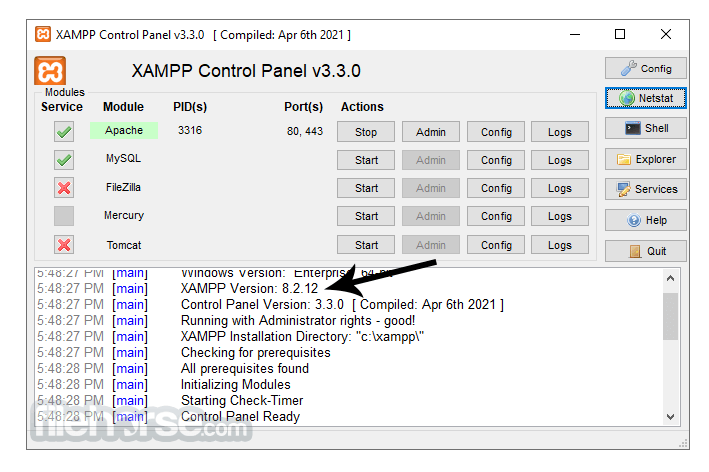Thanks to XAMPP you'll be able to install Apache + PHP + MySQL in just 5 minutes. Forget log and hard steps, you only need to follow steps given by this easy wizard. Although those three parts are the most known, XAMPP can install other utilities such as PHPmyAdmin, OpenSSL, PERL or Webalizer, so you'll be able to have a full-featured server. XAMPP with its related tools make it easier for transitioning from a local test server to live server very quickly. The ready-made solutions from Apps4Rent operates across all platforms including Windows, Linux, and OS X. Xampp is the most popular PHP development environment for Windows, OS X, and Linux platforms. Xampp stands for Cross platform(x), Apache(a), Maria db(m), PHP(p), Pearl(p) which is a software distribution server which makes developer’s work eaiser for testing and deploying by creating a local web server.

This is old.
We now recommend using MAMP instead of XAMPP. See these instructions for setting up for our PHP classes.

XAMPP is a free distribution package that makes it easy to install Apache Web Server, PHP, PEAR, and MySQL. Before installing XAMPP, you should turn off any other web servers and instances of MySQL you have running on your Windows machine.
Installing XAMPP on Windows
- Download and Install Visual Studio 2008 redistributable package because XAMPP will need this to run properly.
- Download and Install XAMPP for PHP 5.X for Windows- Be sure to select the proper version of PHP as there are many choices.
- Allow the program to make changes to your machine.
- It is VERY important to install on the root of c:. If you don't, some functions of XAMPP may have restrictions that will force you to adjust the settings in your UAC, which isn't recommended.
- Double-click on the new XAMPP Control Desktop shortcut or Use the Search feature in Windows 10 to find the XAMPP Control App, which opens up the XAMPP Control Panel Application. There you will see a column of 'Start' buttons. Select the ones for MySQL and for Apache...you should now see a green 'Running' indicator
- NOTE: If you find another service is already running on port 80 on your computer, read our instructions on how to change XAMPP to use a different port like 8080.
Testing your XAMPP Installation
Xampp Phpmyadmin
In your web browser, go to http://localhost. You should see the start page of XAMPP:
Class Files
- After downloading the class files, create a folder in htdocs named 'Webucator' and extract your class files in that folder.
Setting the MySQL Password on Windows
The PHP files use 'pwdpwd' for the MySQL root password, while the default password is NO password.
Xampp Control Panel V3.2.4
- Click Admin next to MySQL on the XAMPP Control Panel to bring up the phpMyAdmin.
- Choose the mysql database on the left.
- Then choose the SQL tab on the top and run the following statement:
- You also need to update line 21 of the xampp/phpMyAdmin/config.inc.php file with the new password (
pwdpwd). Note: In order to connect to the myPHPAdmin center, you must do these steps in order.
Installing Northwind Database using XAMPP
NOTE: you should download the class files above before following these instructions, as it contains the Northwinds Database file(s).
- To install the Northwind database used in class, click Admin next to MySQL on the XAMPP Control Panel to bring up the phpMyAdmin. That should take you to http://localhost/phpmyadmin.
- If it asks you to login, the username is root and the password is pwdpwd.
- On that page, click on the Import link under the Localhost heading. After, it should say 'Importing into the current server'.
- Browse to the Northwind-MySQL.sql file in your class files (c:xampphtdocsWebucator).
- Click the Go button on the bottom left of the page.
- You should get a Success message and Northwind should be added to your list of Databases.
Recommended Code Editor
Visual Studio Code (Download, Install, and Set up)- While you may use a different editor or IDE, Visual Studio Code is an excellent IDE to learn to code on. It provides a nice balance of power and simplicity and it is available on Windows and Mac.
Testing PHP Files
All your class files should be located in C:xampphtdocsWebucatorClassFiles
Xampp Download For Windows 10
To test any of the class files in your browser, say C:xampphtdocsWebucatorClassFilesPHPBasicsDemosHelloWorld.php, you can use 1 of 2 methods:
Xampp Download For Windows 10
- Method 1:
- Go to http://localhost/Webucator/ClassFiles/PHPBasics/Demos/HelloWorld.php in your web browser.
- Follow the same pattern to view all other class files; basically the C:xampphtdocs gets changed to http://localhost/
- Method 2:
- Go to http://localhost/Webucator/ClassFiles/ in your web browser.
- Bookmark that page in your browser for easy access to it from now on.
- From there, you can see all the lesson folders and drill down to any class file for testing/viewing.
And that's it
Xampp For Windows 64 Bit Windows 10
Happy Windows XAMPPing!
